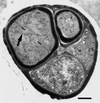Ionizing-radiation resistance in the desiccation-tolerant cyanobacterium Chroococcidiopsis
- PMID: 10742231
- PMCID: PMC92012
- DOI: 10.1128/AEM.66.4.1489-1492.2000
Ionizing-radiation resistance in the desiccation-tolerant cyanobacterium Chroococcidiopsis
Abstract
The effect of X-ray irradiation on cell survival, induction, and repair of DNA damage was studied by using 10 Chroococcidiopsis strains isolated from desert and hypersaline environments. After exposure to 2.5 kGy, the percentages of survival for the strains ranged from 80 to 35%. In the four most resistant strains, the levels of survival were reduced by 1 or 2 orders of magnitude after irradiation with 5 kGy; viable cells were recovered after exposure to 15 kGy but not after exposure to 20 kGy. The severe DNA damage evident after exposure to 2.5 kGy was repaired within 3 h, and the severe DNA damage evident after exposure to 5 kGy was repaired within 24 h. The increase in trichloroacetic acid-precipitable radioactivity in the culture supernatant after irradiation with 2.5 kGy might have been due to cell lysis and/or an excision process involved in DNA repair. The radiation resistance of Chroococcidiopsis strains may reflect the ability of these cyanobacteria to survive prolonged desiccation through efficient repair of the DNA damage that accumulates during dehydration.
Figures





References
-
- Battista J R. Against all odds: the survival strategies of Deinococcus radiodurans. Annu Rev Microbiol. 1997;51:203–224. - PubMed
-
- Billi, D., and M. Potts. Life without water: responses of prokaryotes to desiccation. In K. B. Storey and J. M. Storey (ed.), Cellular and molecular responses to stress, in press. JAI Press, Stamford, Conn.
-
- Dose K, Bieger-Dose A, Labusch M, Gill M. Survival in extreme dryness and DNA-single-strand breaks. Adv Space Res. 1992;12(4):221–229. - PubMed
Publication types
MeSH terms
LinkOut - more resources
Full Text Sources
Other Literature Sources

